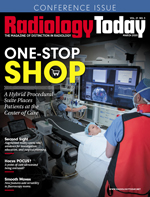 Editor’s Note: Expanded Repertoire
Editor’s Note: Expanded Repertoire
By Dave Yeager
Radiology Today
Vol. 21 No. 3 P. 6
Although it’s too early to tell exactly how value-based care will come to be defined, new capabilities are one way that medical practices can differentiate themselves and demonstrate value. Whether that’s through combining modalities in new ways, getting more from existing modalities, or developing entirely new modalities to improve patient care, the race to efficiency is on. This month, we’re exploring some ways that medical imaging is changing the delivery of medical care.
First up, Kathy Hardy’s cover feature provides a closer look at the Mayo Clinic’s Hybrid Procedural Suite. Combining multiple modalities in a suite of operating rooms, the Hybrid Procedural Suite allows image-guided procedures to be delivered faster with less patient repositioning. It’s still quite new, but Mayo’s clinicians are giving it enthusiastic reviews.
Existing modalities are also expanding their range. Keith Loria has a round-up of what’s new in fluoroscopy. Some of the motivations behind the Hybrid Procedural Suite are at play here: less patient movement, easier control of the equipment, and less wasted time. Turn to page 20 to read more about the latest and greatest features.
Another way to improve image-guided procedures is to coregister patient imaging with actual anatomy. Beth W. Orenstein reports on an augmented reality system that allows interventional radiologists to plan and perform procedures more effectively, while offering a path to more interactive radiology education. Recent upgrades have made the system easier to use, and it could potentially fill a useful niche.
Extending modality use to more users holds potential, as well, but there are some concerns about how much is too much. Orenstein takes a look at a recent report by the ECRI Institute that raised some red flags about point-of-care ultrasound. The institute’s report questions whether the technology is being overused and suggests that more training and oversight are needed. The experts that Orenstein speaks with, however, say that POCUS is a valuable adjunct to care, especially for first response, and they believe that adequate training is already in place.
Finally, we’re pleased to announce the launch of our USMLE study guide. Medical students need to familiarize themselves with medical imaging to identify a range of conditions, and Alex Merkulov, MD, our section editor for On the Case, has compiled a handy guide to help them do that. Visit www.radiologytoday.net/USMLE to begin your tour.
Enjoy the issue.
david.yeager@gvpub.com

